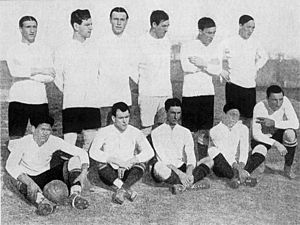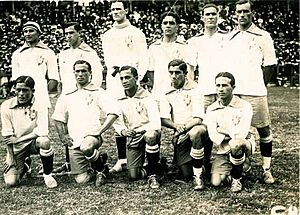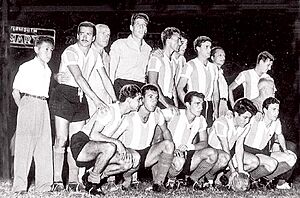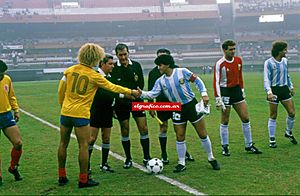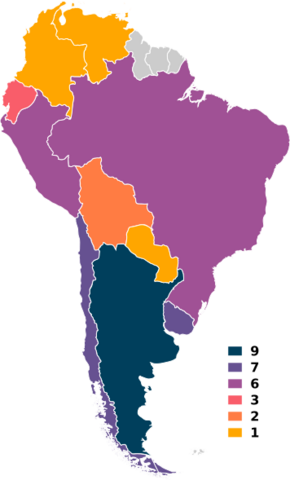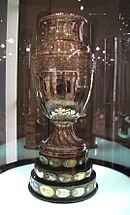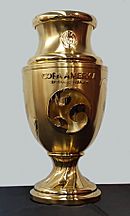Copa América facts for kids
 |
|
| Organizing body | CONMEBOL |
|---|---|
| Founded | 1916 |
| Region | South America |
| Number of teams | 16 (2024) |
| Qualifier for | Finalissima |
| Related competitions | Copa América Femenina |
| Current champion(s) | |
| Most successful team(s) | |
The CONMEBOL Copa América is a major football tournament for men's national teams in South America. It is often called simply the Copa América. This competition is the oldest still-running continental football tournament in the world. It decides the champions of South America.
Since the 1990s, teams from North America and Asia have also been invited to play. Eight of the ten South American teams have won the tournament. Only Ecuador and Venezuela have not won it yet. Argentina has won the most championships, with 16 titles. Argentina has also hosted the tournament the most times (nine times), including the very first one in 1916. The United States is the only non-South American country to host, doing so in 2016 and 2024.
Since 1993, the tournament usually has 12 teams. This includes all 10 South American teams and two invited teams from other regions. For example, Mexico played in many tournaments. In 1999, Japan from Asia played. In 2019, Japan and Qatar were invited. The 2016 and 2024 tournaments were bigger, with 16 teams. They included six teams from North America along with the 10 from South America.
Contents
History of the Copa América
Early Years: 1916 to 1967
How the Tournament Started
Football became very popular in South America in the early 1900s. In 1916, Argentina hosted a tournament to celebrate its independence. This event included teams from Argentina, Chile, Uruguay, and Brazil. This was the first official Campeonato Sudamericano de Football, which is now known as the Copa América. Uruguay won this first tournament.
After this success, a group of football officials decided to create a confederation. On July 9, 1916, CONMEBOL was founded. The next year, Uruguay hosted the tournament and won again. This helped make the tournament a regular event.
In 1919, Brazil hosted and won its first title. In 1920, Uruguay won the event held in Chile. In 1921, Paraguay joined the tournament for the first time. Argentina won its first title that year. Uruguay and Argentina then became the strongest teams. Bolivia and Peru also joined the tournament in 1926 and 1927.
Changes and Breaks: 1930 to 1967
After the first World Cup in 1930, the tournament stopped for a few years. This was because of disagreements between Uruguay and Argentina. It started again in 1935 and officially returned in 1939. Peru hosted and won the competition for the first time in 1939. Ecuador also played for the first time.
In 1941, Chile hosted the tournament. Argentina won that year. Uruguay hosted and won in 1942. Argentina then won three titles in a row in 1945, 1946, and 1947. After this, the tournament was held less often. Sometimes, teams did not send their best players. For example, in 1959, Brazil sent a team from one of its states. Bolivia won its first title in 1963. The creation of the Copa Libertadores in 1959 also changed how teams viewed the tournament.
Modern Era: 1975 to Present
New Name and Format: 1975 to 1987
After an eight-year break, the tournament returned in 1975. It was officially renamed the Copa América. There was no single host country. Matches were played in different countries throughout the year. This format was used until 1987. The tournament also changed from a round-robin style to a group stage with knockout rounds and a final.
Rotating Hosts: 1987 to 2015
In 1986, CONMEBOL decided to have one host country again. The tournament would be held every two years. From 1987 to 2001, the ten member countries took turns hosting. This helped the tournament become more popular, with TV coverage in Europe and North America. Argentina hosted in 1987, the first time in 28 years. Even with stars like Diego Maradona, Argentina finished fourth. Uruguay won that year.
Brazil won its first major international title since 1970 by winning the 1989 Copa América at home. Argentina won the Copa América in 1991 after 32 years. This team included the famous goalscorer Gabriel Batistuta. The 1993 tournament in Ecuador introduced the current format. Two teams from North America, Mexico and the United States, were invited to play.
Uruguay won the competition in 1995 as the host. Countries like Colombia, Paraguay, and Venezuela hosted the tournament for the first time. Brazil then won four of five titles between 1997 and 2007. In 2001, Honduras surprisingly knocked out Brazil. Colombia, the host, won the competition for the first time.
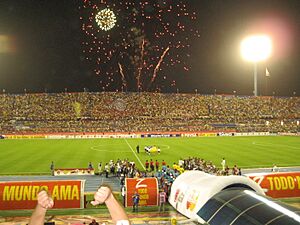
From 2001 to 2007, the tournament was held every three years. Since 2007, it has been held every four years, except for the special 2016 tournament. Brazil won against Argentina in the 2004 final. They met again in the 2007 final, where Brazil won 3-0.
Argentina hosted in 2011 but was eliminated by Uruguay. Uruguay went on to win the trophy on Argentine soil. This was the first time neither Argentina nor Brazil reached the semifinals when both played. Chile hosted the 2015 competition and won their first title at home.
Centenary and Future: 2016 to Present
In 2016, the tournament's 100th anniversary was celebrated with the Copa América Centenario in the United States. This was the first time the tournament was held outside South America. It had 16 teams from both South and North America. Chile won the trophy again in a penalty shootout. The 2016 event set new records for attendance.
Brazil hosted the 2019 edition and won their ninth title. CONMEBOL decided to move the tournament to even years, like the UEFA European Championship. The 2020 Copa América was planned for Argentina and Colombia. However, it was postponed to 2021 due to the COVID-19 pandemic. Two invited teams, Australia and Qatar, withdrew. Colombia also withdrew as a host. The entire 2021 tournament was moved to Brazil. It was played with no fans in most matches. Argentina won their first title in 28 years by beating Brazil in the final.
In January 2023, CONMEBOL and CONCACAF agreed to work together. As part of this, the United States was chosen to host the 2024 Copa América. This tournament included six North American teams. Some venues were also used for the 2026 FIFA World Cup.
Host Countries
Since 1984, CONMEBOL has rotated the hosting rights among its ten member countries. The first rotation finished in 2007 when Venezuela hosted. A second rotation started in 2011, with countries hosting in alphabetical order. Argentina hosted in 2011.
Brazil was supposed to host in 2015. But because Brazil was also hosting the 2014 FIFA World Cup and the 2016 Summer Olympics, they swapped with Chile. Chile hosted in 2015 instead. The special 2016 Copa América Centenario was held in the United States. This was the first time a non-South American country hosted the tournament.
Each Copa América since 2005 has had its own mascot. Gardelito, from the 1987 competition, was the first Copa América mascot.
| Hosts | Editions hosted |
|---|---|
| 9 (1916, 1921, 1925, 1929, 1937, 1946, 1959, 1987, 2011) | |
| 7 (1917, 1923, 1924, 1942, 1956, 1967, 1995) | |
| 7 (1920, 1926, 1941, 1945, 1955, 1991, 2015) | |
| 6 (1919, 1922, 1949, 1989, 2019, 2021) | |
| 6 (1927, 1935, 1939, 1953, 1957, 2004) | |
| 3 (1947, 1959, 1993) | |
| 2 (1963, 1997) | |
| 2 (2016, 2024) | |
| 1 (1999) | |
| 1 (2001) | |
| 1 (2007) | |
| home-and-away basis | 3 (1975, 1979, 1983) |
-
C = non-CONMEBOL host.
How the Tournament Works
In the early tournaments, all teams played each other in a round-robin style. Later, teams were divided into groups. After the group stage, there was a knockout stage to decide the winner.
Teams That Play
All ten national football federations in CONMEBOL automatically qualify for the tournament. Only once, in 2001, did Argentina withdraw due to scheduling and security issues.
Because there are only ten South American teams, countries from other continents are often invited. This helps make up the 12 teams needed for the current tournament format. Most invited teams are from North America, as they are geographically close. For the 2016 and 2024 tournaments, which had 16 teams, North American teams had to qualify.
Ten non-South American countries have played in the Copa América. These include teams from North America like Canada, Costa Rica, Haiti, Honduras, Jamaica, Mexico, Panama, and the United States. Also, Asian teams like Japan and Qatar have participated.
Trophies and Awards
The Copa América trophy is given to the winning team. It was first given in 1910 for a special tournament. The current trophy was bought in 1916 from a jewelry shop in Buenos Aires. It cost 3,000 Swiss francs.
The Copa América trophy is a silver ornament that weighs 9 kg (20 lbs) and is 77 cm (30 inches) tall. It has a wooden base with plaques. These plaques are engraved with the names of every winning team and the year they won.
In 2016, a special trophy was made for the Copa América Centenario. This was to celebrate the tournament's 100th anniversary. This trophy looked like the original but had the 2016 logo. It was 61 cm (24 inches) tall and weighed 7.1 kg (15.7 lbs). It was covered in 24-carat gold. The winning team kept this special trophy forever.
Besides the main trophy, a smaller silver trophy called the "Copa Bolivia" is given to the runner-up. This started in 1997. It is named after Bolivia, which hosted the 1997 tournament.
There are also several awards given after the tournament:
- The Best Player award for the most valuable player.
- The Top Goalscorer award for the player who scores the most goals.
- The Best Goalkeeper award for the best goalkeeper.
- The Team of the Tournament for the best combined team of players.
- The Fair Play Award for the team with the best sportsmanship.
Tournament Winners
Teams Reaching the Top Four
| Team | Title(s) | Runners-up | Third place | Fourth place |
|---|---|---|---|---|
| 16 (1921*, 1925*, 1927, 1929*, 1937*, 1941, 1945, 1946*, 1947, 1955, 1957, 1959*, 1991, 1993, 2021, 2024) | 14 (1916*, 1917, 1920, 1923, 1924, 1926, 1935, 1942, 1959, 1967, 2004, 2007, 2015, 2016) | 5 (1919, 1956, 1963, 1989, 2019) | 2 (1922, 1987*) | |
| 15 (1916, 1917*, 1920, 1923*, 1924*, 1926, 1935, 1942*, 1956*, 1959, 1967*, 1983, 1987, 1995*, 2011) | 6 (1919, 1927, 1939, 1941, 1989, 1999) | 10 (1921, 1922, 1929, 1937, 1947, 1953, 1957, 1975, 2004, 2024) | 5 (1945, 1946, 1955, 2001, 2007) | |
| 9 (1919*, 1922*, 1949*, 1989*, 1997, 1999, 2004, 2007, 2019*) | 12 (1921, 1925, 1937, 1945, 1946, 1953, 1957, 1959, 1983, 1991, 1995, 2021*) | 7 (1916, 1917, 1920, 1942, 1959, 1975, 1979) | 3 (1923, 1956, 1963) | |
| 2 (1953, 1979) | 6 (1922, 1929, 1947, 1949, 1963, 2011) | 7 (1923, 1924, 1925, 1939, 1946, 1959, 1983) | 7 (1921, 1926, 1937, 1942, 1967, 1989, 2015) | |
| 2 (2015*, 2016) | 4 (1955*, 1956, 1979, 1987) | 5 (1926*, 1941*, 1945*, 1967*, 1991*) | 11 (1916, 1917, 1919, 1920, 1924, 1935, 1939, 1947, 1953, 1999, 2019) | |
| 2 (1939*, 1975) | 1 (2019) | 8 (1927*, 1935*, 1949, 1955, 1979, 1983, 2011, 2015) | 6 (1929, 1941, 1957*, 1959, 1997, 2021) | |
| 1 (2001*) | 2 (1975, 2024) | 5 (1987, 1993, 1995, 2016, 2021) | 2 (1991, 2004) | |
| 1 (1963*) | 1 (1997*) | 0 | 2 (1927, 1949) | |
| 0 | 2 (1993, 2001) | 3 (1997, 1999, 2007) | 0 | |
| 0 | 0 | 1 (2001) | 0 | |
| 0 | 0 | 0 | 2 (1959*, 1993) | |
| 0 | 0 | 0 | 2 (1995, 2016*) | |
| 0 | 0 | 0 | 1 (2011) | |
| 0 | 0 | 0 | 1 (2024) |
-
* Host nation
Images for kids
-
Carlos Valderrama and Diego Maradona greeting before a match in 1987.
-
A match from the 2007 Copa América, held in Venezuela.
See also
 In Spanish: Copa América para niños
In Spanish: Copa América para niños
- Copa América Femenina
- Copa América Centenario
- Copa Centenario Revolución de Mayo
- Continental football championships
- Panamerican Championship


